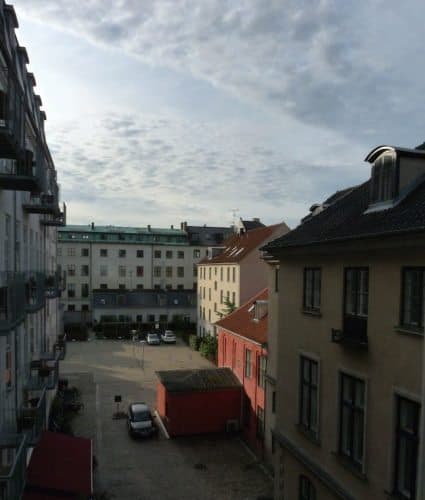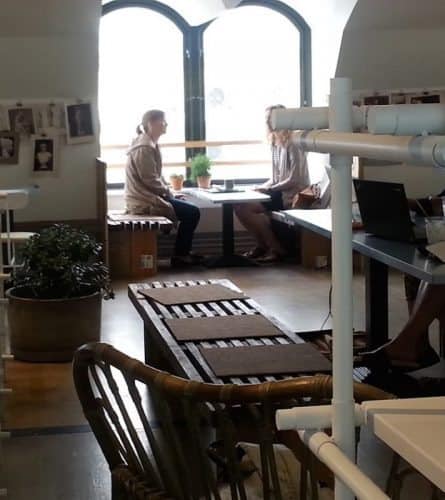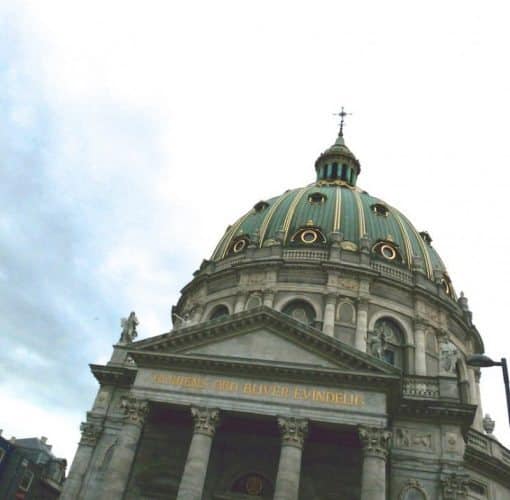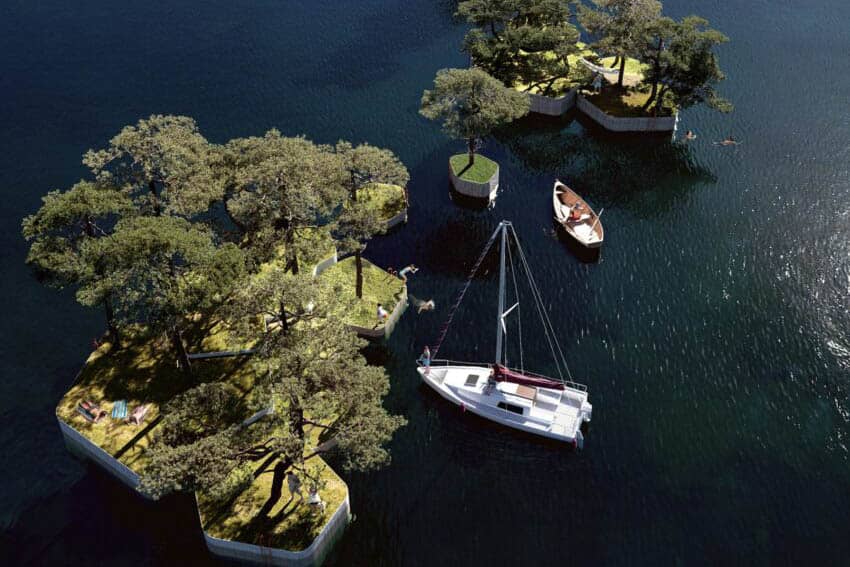
Copenhagen Onscreen: Following the footsteps of The Danish Girl
By Faye S. Wolfe

There’s a special little thrill to be had in seeing a movie set in a place you love. I watched the film, “The Danish Girl” with an eagerness at odds with its deepening tragic tone, thrilled to catch glimpses of places in Copenhagen I’d explored not long ago.
Love it or hate it—reactions to this poetic, anguished account of Einar Wegener’s transgender transformation into Lili Elbe run the gamut—the movie is beautiful, and its Copenhagen setting accentuates the mood and underlines the tale’s themes.
The cloudy light, the shimmer of the nearby sea in the air, the subdued but saturated colors of the buildings, the shadowy interiors: all add texture. And scouting The Danish Girl’s locations can take you to some intriguing spots.
Nyboder, for instance: this district of two-story stuccoed rowhouses lining wide cobbled streets has an almost haunted, strangely appealing atmosphere.

In an evocative moment in the movie, a lone cyclist wheels down a deserted Nyboder block as Einar (Eddie Redmayne) comes into view on one of his first outings as Lili.
En route to visit a new friend, the poet Henrik Sander (Ben Whishaw), Lili cautiously slips past the buildings on Suensonsgade, which are painted a distinctive ocher shade known to Danes as “Nyboder yellow.”
Apparently, the film’s location scouts shouted, “Stop the car, stop the car!” when they drove by this neighborhood in north-central Copenhagen. I had that wow! reaction coming upon it a few blocks from my hotel (the Babette—more about it later) and once again watching the movie.
There’s a frozen-in-time quality about this quarter, created to house Royal Navy sailors and workers and their families.
The first buildings went up in the 1600s; more were added in the 1700s and again in the 1800s; some have since been razed or rebuilt, and the renovation continues today.
Some military personnel still live there. Perhaps the blue of Lili’s dress in the Nyboder scene was a subtle nod to the setting’s naval connection.
Near Delfingade, Krokodilegade, and Tigergade—Dolphin, Crocodile, and Tiger Streets; alas, Pindsvinegade, Hedgehog Street is no more—is another cluster of nineteenth- and early twentieth-century cottages, built as affordable housing for workers, that could be straight out of an old storybook.
If you seek out Krusemyntegade and the lanes nearby, you’ll find cheerful facades painted bright blue, rose, soft gray. In summer, lavishly blooming roses frame doorways, and hollyhocks spring, improbably, in profusion, from the merest cracks in the cobblestones.
Always Ready for its Close-up

Equally colorful and beautiful is the old waterway that is Nyhavn. In the film, the bedroom windows of Einar/Lili and wife Gerda look out on this canal-like harbor.
Its oldest buildings date from the 1600s; Hans Christian Andersen lived in this district, variously, at 18, 20, and 67. For the movie, Nyhavn was transformed into a busy market with women fishmongers in shawls and aprons and folded-newspaper hats and a ton of fish in wooden crates.
Nowadays, especially in warm weather, it’s crowded with tourists, not brimming baskets of flounder. Nyhavn’s picture-postcard look is part of the attraction, as are the bars, shops, and outdoor cafes where you can pick your poison: a beer, ice cream, hot chocolate, a burger.

The scenes depicting Lili’s happy moments as a sales clerk in the exclusive Fonnesbech department store were actually shot in London’s Park Lane Hotel.
In the 1970s, Fonnesbech refashioned itself as a high-end clothing brand, so if you want a sense of retail’s belle epoque, head to Kongens Nytorv, a major city square, to gaze upon the Magasin du Nord, an impressive pile built in 1894. (www.magasin.dk)
The store got its start in the Hotel du Nord, which stood on the same spot and was demolished to make way for the present building, and Hans Christian Andersen had a room there, too (which has been re-created in the present building).
Inside, the store décor is as contemporary and chic as the merchandise on display; its top-floor café offers a great view. During filming, incidentally, Eddie Redmayne was waylaid by fans when he paid Magasin a visit.
Like the Park Lane Hotel, Frederiks Kirke, known as the Marmorkirken (Marble Church) stands in for someplace else, but in this case, it’s a Copenhagen landmark pretending to be Parisian (www.marmorkirken.dk).
Its massive dome, one of the largest in Europe, looms in the background of a street scene. In reality, the church can be found just down the street from Amalienborg, the royal residence.
A Frenchman, Nicolas Henri Jardin, was one of three architects commissioned to design the church. The first drew up plans in 1740, but marble buildings have never come cheap, and the project languished for more than a century.
The church was finally consecrated in 1894, the same year as that shrine to commerce, the Magasin du Nord, opened in its current form. You can admire the Marmorkirken’s cool beauty—verdigris crown, marble surfaces, classical flourishes—from the central fountain of the Amalie gardens, or venture in to appreciate its gorgeous interior and climb to the bell tower for a vista of the harbor.

Set the Mood
The Statens Museum for Kunst (National Gallery of Denmark) doesn’t appear at all in the movie, but it’s one place to see some of Vilhelm Hammershoi’s alluring paintings, the inspiration behind the look of Lili and Gerda’s apartment. (www.smk.dk)
The masterful artist was born, lived, and painted in Copenhagen. In many of his works, sparsely furnished rooms are rendered in a muted palette of pale grays, taupes, blues, and other neutrals.
Light comes from a tall window. The room is empty, or a woman in a long dark dress stands with her back to the viewer. For The Danish Girl, set designers translated Hammershoi’s moody interiors into a restrained backdrop for the characters’ high emotions.
While you’re there, don’t miss the atmospheric seascapes of another nineteenth-century Norwegian painter Peder Balke, whose work received rave reviews in a 2015 exhibition in London’s National Gallery. (Truly, you could spend hours viewing the museum’s dazzling collection of art, spanning 700 years.) Just across the lake, the
Hirschsprung Collection also has beautiful Hammershoi paintings on display (www.hirschsprung.dk), as does the Carlsberg Glyptotek (www.glyptoteket.dk), and both museums are well worth your time.
From March 1, the David Collection in Copenhagen is showing Hammershoi works from the Ordrupgaard Museum. (www.davidmus.dk).
Yes, yes, Babette
One more stop on The Danish Girl tour: the very pretty, slightly kooky Hotel Babette Guldsmeden. It’s where Eddie Redmayne, Alicia Vikander, and the film crew stayed during the Copenhagen shoot.
One of a chain of “nouveau-bohême boutique hotels with a strong focus on sustainability,” according to Guldmeden, the Babette is colorful and inviting, with some surprising touches, such as a cowhide-paneled elevator.
Other elements are purely charming: the plant-filled hall off Reception, furry throws on cushy leather couches in the lobby, turquoise bikes for guests in a rack outside. And dragonflies (guldsmeden in Danish) alight all over, imprinted on lampshades, notepads, the front doors.
The rooms aren’t uniform in layout or look, but many have high ceilings, tall windows, simple canopy beds, kilims on the floor, and bright Indonesian pillows. In fact, a lot of the furnishings have a Balinese pedigree, and after an afternoon with Hammershoi, the overall scheme is both exotic and hygge, as the Danes might say: cozy, warm, relaxing.
The baths are elegantly appointed with stone basins and tubs or spacious showers and goody boxes of the hotel’s line of toiletries, made from organic, botanical ingredients.

Besides Nyboder and the Marmorkirken, other Copenhagen landmarks and attractions are nearby, but if your behind-the-scenes tour has tuckered you out, stay on the premises for a cocktail at the chummy bar or a meal in the Brasserie Babette, or treat yourself to a sauna at the rooftop spa.
(A couple of caveats: This hotel has its quirks. Our room wasn’t quite big enough for two; the closet was minuscule, and the bedside table snagged a shin if you weren’t careful.
Hardest of all for my spouse, he discovered that although he could get a delicious, locally brewed beer there, the bar wasn’t stocked to provide a traditional gin martini with proper olives.)
For more on Copenhagen as seen through the movie’s lens, visit this website, and Watch a trailer of The Danish Girl on YouTube.
Eurail Passes: What to Know about Buying a Europe Train Pass
- These 9 U.S. National Parks Require Reservations in 2024 - April 17, 2024
- Take a Hike in Olympic National Park - April 17, 2024
- The Wild Mississippi: 2340 Miles Across Ten States - April 8, 2024


